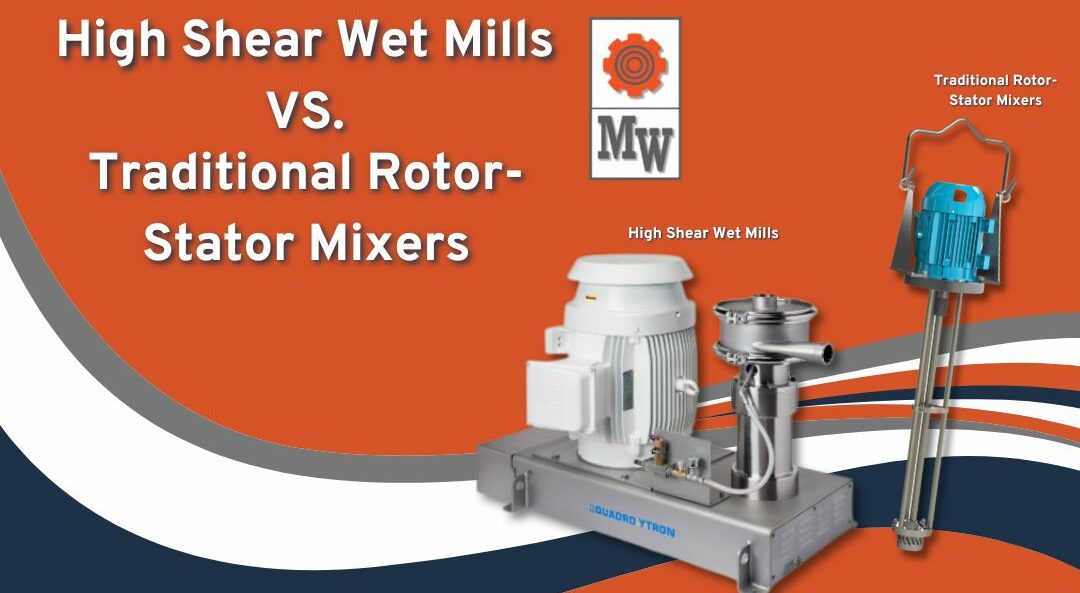In the realm of industrial processing, the choice of equipment can profoundly impact efficiency, product quality, and ultimately, the bottom line. When it comes to mixing applications, two prominent contenders emerge: High Shear Wet Mills and Traditional Rotor-Stator Mixers. While both serve the purpose of mixing and dispersing materials, they differ significantly in design, functionality, and performance.
Let’s begin by clarifying the definition of each technology and then delve into the differences between the two.
At its essence, a Traditional Rotor-Stator Mixer is a mechanical device designed to blend, homogenize, and disperse materials through the interaction of rotating and stationary components. The mixer typically consists of a rotor, equipped with blades, vanes, or other agitating elements, that rotates within a stationary stator housing. This rotor-stator configuration creates a dynamic flow pattern, effectively shearing, folding, and mixing the materials as they pass through the mixing chamber.
Conversely, at its core, a High Shear Wet Mill is a specialized piece of equipment engineered to disperse, emulsify, and homogenize materials in a liquid medium with exceptional precision and efficiency. Unlike conventional mixers and mills, High Shear Wet Mills leverage a unique rotor-stator configuration to impart high shear forces on the product, facilitating rapid and thorough mixing.
Now that we have explained the technology, let’s explore the key distinctions between these two technologies to better understand their respective roles in industrial processing.
Design and Operating Principle
High Shear Wet Mills: High Shear Wet Mills features a specialized rotor-stator configuration, where a rotating rotor equipped with intermeshing blades or teeth operates within a stationary stator housing. This design creates intense hydraulic shear forces as the product passes through the narrow gap between the rotor and stator, facilitating thorough mixing, emulsification, and particle size reduction in a liquid medium.
Traditional Rotor-Stator Mixers: Traditional Rotor-Stator Mixers, on the other hand, consist of a rotating rotor with blades or vanes that interact with a stationary stator. While similar in concept to High Shear Wet Mills, these mixers typically operate at lower speeds and may lack the precise rotor-stator geometry required for high shear mixing. As a result, they may struggle to achieve the same level of dispersion and particle size reduction, particularly in viscous or challenging applications.
Shear Forces and Mixing Efficiency
High Shear Wet Mills: High Shear Wet Mills generate intense shear forces due to their high tip speeds and precise rotor-stator geometry. These shear forces effectively break down particles, disperse components, and promote uniform mixing within the liquid medium. As a result, High Shear Wet Mills excel in achieving fine particle size control, uniform distribution, and rapid mixing, making them ideal for applications where product quality and consistency are paramount.
Traditional Rotor-Stator Mixers: While Traditional Rotor-Stator Mixers also generate shear forces during operation, they may lack the high tip speeds and precise rotor-stator configuration of High Shear Wet Mills. Consequently, they may exhibit lower mixing efficiency, longer processing times, and reduced control over particle size distribution. While suitable for certain applications, Traditional Rotor-Stator Mixers may struggle to meet the stringent requirements of industries such as pharmaceuticals, cosmetics, and specialty chemicals.
Versatility and Application Range
High Shear Wet Mills: High Shear Wet Mills offer versatility across a wide range of applications and materials, including emulsions, suspensions, slurries, and pastes. They can handle challenging materials with ease, achieving uniform dispersion and particle size reduction even in highly viscous or abrasive formulations. This versatility makes them indispensable in industries such as pharmaceuticals, food processing, and paints and coatings.
Traditional Rotor-Stator Mixers: Traditional Rotor-Stator Mixers may find application in less demanding processes or where fine particle size control is not critical. They are suitable for general mixing, blending, and homogenization tasks across various industries but may struggle with achieving the precision and consistency required in specialized applications.
In summary, the choice between High Shear Wet Mills and Traditional Rotor-Stator Mixers hinges on the specific requirements of each industrial process. While both technologies serve the purpose of mixing and dispersing materials, High Shear Wet Mills offer superior performance in terms of precision, efficiency, and versatility, particularly in applications where fine particle size control and uniformity are paramount. By understanding the distinctions between these technologies, industrial processors can make informed decisions to optimize their operations and achieve superior results.
Still unsure about which is the right choice for you? Our team of product experts is happy to help.
Contact us today or give us a call at 630-924-1208.

